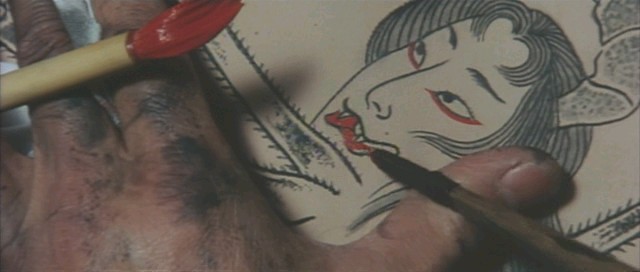« Kisses | Main | Coffee Break »
August 18, 2011
Irezumi

Yasuzo Masumura - 1966
Yume Pictures Region 2 DVD
Is there anything to explain why Kaneto Shindo, a director in his own right, served as screen writer for two films directed by Yasuzo Masumura, both based on the writings of Junichiro Tanizaki? The better known of these two films is Manji, also starring frequent Masumura muse, Ayako Wakao. Irezumi has recently been screened as part of some retrospectives, providing this film a higher profile.
Otsuya, the daughter of a pawn broker, runs away with her lover, Shinsuke, the apprentice to her father. I'm unsure about the time period as everyone wears kimonos, but I'm guessing near the end of the samurai era in the 19th Century. Taken in a family friend, Otsuya is kidnapped and sold to a geisha house, while Shinsuke is taken others to be killed. Shinsuke manages to kill his would be murderer and lives the life of a fugitive. Otsuya is further objectified when an artist is allowed to tattoo a giant spider on her back. The spider, with the face of a female demon, is the alleged cause of Otsuya taking advantage of various men in her life, leaving them at best without money, or at worst, without their lives.

In several ways, Irezumi is the opposite of Masumura's Kisses. Unlike the earlier film, where the characters take responsibility for their actions, the characters here blame outside forces for their transgressions. Rather than trying to live pure lives in an impure world, Otsuya and the others dive straight into the cesspool. Also, unlike the natural, and real life settings of Kisses, Irezumi was shot entirely in a studio, with unnatural appearing exteriors. In one scene, Otsuya and Shinsuke are standing on a bridge in the snow. Otsuya threatens to drown herself in the water below the bridge which remains unseen. Masumura barely disguises that the scene could just as well have been taking place on a theater stage. And as Kisses ends optimistically, Irezumi ends with the death of virtually every major character.
Masumura is said to have been unhappy with the cinematography by Kazuo Miyagawa, although that didn't seem to stop them from working in the future. What is most visually interesting is how some of the scene are framed. Almost like the layers of Ayako Wakao's kimonos, not everything is revealed with the scope screen. Parts of the frame are blocked off with shoji screens, walls, doors, or simply the positioning of the actors. The emphasis would be on the insularity of the characters, most of whom find themselves emotionally, if not physically trapped.
Ayako Saito has an essay on the collaboration between Masumura and Wakao. What makes Irezumi of interest is that it is both self-critical and self-contradictory. In Masumura's films, Wakao plays women who can be described as independent and self-assertive, unlike the traditional portrait of Japanese women. Otsuya is essentially made into an object for the benefit of the male gaze, yet turns her status as a way of extracting revenge on those who would use her for their own sexual or financial benefit. To some extent, the primarily male audience, for whom the film was made, as well as the filmmakers, are implicated with the frequent shots of a partially nude Wakao, where she displays her back and the tattoo. The essay, found in the collection, Reclaiming the Archive: Feminism and Film History explores not only what is to be seen in the films made by Masumura with Wakao, but also the extent to which Wakao expressed herself artistically rather than simply serve the director's muse.

Posted by Peter Nellhaus at August 18, 2011 08:00 AM
